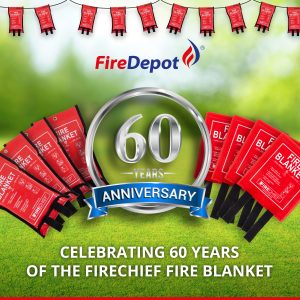It’s probably a little-known fact that the first ‘Homesaver’ (later Firechief) Fire Blanket was created in a garden shed in Gloucestershire in 1963, which makes this year our 60th anniversary!
Firechief Fire Blankets have come a long way since then. In 1997 the ‘Homesaver’ fire blanket achieved BSI Kitemark accreditation to BSEN1869 and more recently the Firechief Fire Blanket became one of the first to be accredited to the new BSEN1869:2019 standard.
To mark our 60 years in fire safety, we take a look at some interesting facts about Fire Blankets which you may not know:
- The practice of smothering fire with heavy materials such as coats, rugs, or blankets, goes way back. In fact, it’s thought that the very first fire extinguishing material may have been animal skins.
- During the early 1900s, more conventional firefighting equipment such as fire blankets and fire extinguishers were developed and became more widely used.
- By the 1960’s the fire blankets made of leather, wool and latterly asbestos, were being replaced by those made from glass fibre cloth.
- At this stage, there were no formal manufacturing standards for fire blankets as a finished product for extinguishing fire, except that the glass fibre cloth had been tested against BS476 part 4 (non-combustibility) and part 7 ( surface spread of flame). The failures of these blankets in real fires and consumer tests in the early 1980’s led to the introduction of BS6575.
- In 1985 BS6575 was launched and contained manufacturing and testing requirements for light and heavy-duty fire blankets. This along with Kitemarking meant that fire blankets now had a recognised standard of performance.
- 1997 saw the UK implement European Standard BS EN 1869 for light duty fire blankets. Under this standard, a fire blanket must meet the requirements on the maximum allowed weight, have clear instructions and the necessary flexibility to drape and wrap around all likely items on fire.
- Today, Fire Blankets generally consist of glass fibre or Kevlar and flame-retardant material all folded into a quick release case for easy storage and access.
- It’s imperative that Fire Blankets are correctly serviced in accordance with the Fire Industry Association Code of Practice and replaced if used or alternatively at the FIA 7-year recommended lifespan. Unlike fire extinguishers, it is rare for fire blankets to be replaced routinely but they can fray and degrade, stiffen, soak up contaminants (especially in greasy kitchen environments) and otherwise lose their ability to perform. Bear in mind that an existing BS EN 1869:1997 standard fire blanket could be up to 25 years old!
- The new comprehensively updated and reissued BS EN 1869:2019 standard introduced updated testing. In BSEN 1869: 1997 the testing scope was limited to the use of fire blankets on cooking oil fires, despite the fact that they are often are installed for a far wider range of risks than those in the kitchen. With the updated 2019 standard, the original tests for electrical conductivity and cooking oil fires are now joined by a typical small, contained Class B fire using heptane. This gives users reassurance that a tested and approved blanket to BS EN 1869:2019 is truly effective on the wide range of small fires in Classes A, B and F, including where live electrical equipment is involved.
- Under both the existing and the new standards, a fire blanket must meet the requirements on the maximum allowed weight, clear instructions and have the necessary flexibility to drape and wrap around all likely items on fire. However, under the new 2019 standard, for the first-time blankets have to be marked with batch numbers to allow traceability and ageing. This is something that has been an issue in the past with relation to recalls, determining age and verifying test claims.
- Watch out for fake Fire Blankets!: As highlighted in the BBC’s Fake Britain consumer series in recent years, the UK has been flooded with cheap fake Fire Blankets. These are usually sold online and have no fire performance at all. Many claim manufacture to EN 1869, some fraudulently claiming independent approval citing TUV certification or a non-existent kitemark license number.
- To be sure that a Fire Blanket will perform adequately in any of the designed for (and independently tested) risks, you need to look for approval markings to BS EN 1869:2019 accompanied by the official logo/mark of an approved body such as the LPCB or BSI, not just a reference number. The best thing is to double check the blanket manufacturer’s listing against the LPCB Red Book or BSI Kitemark Check service as appropriate. One of the many advantages of the BSI Kitemark is the reassurance that it gives customers as a mark of quality, safety, and trust.
- The Firechief BPR1/K40 became one of the first fire blankets to be certified to the new BS EN 1869:2019 standard. You can read more here FIRECHIEF BPR1/K40 FIRE BLANKET NOW CERTIFIED TO BS EN 1869:2019 - Fire Depot
Fire Depot has been the UK's favourite fire safety supplier for the last 60 years and we know the fire protection and prevention business inside out. Our experienced team can offer advice and guidance about any of our fire safety products. For expert help and advice, please contact the Fire Depot team on 0330 999 2233, email us at sales@firedepot.co.uk or visit https://www.firedepot.co.uk/ to see our full range of fire safety products.
The information contained within this blog is provided solely for general informational and educational purposes and is not intended as a substitute for professional advice. Before taking any actions based upon this information, we advise the reader to consult any and all relevant statutory or regulatory guidance and where felt necessary to consult a qualified fire or industry regulation professional. The use or reliance on any information contained herein is solely at the reader’s risk
